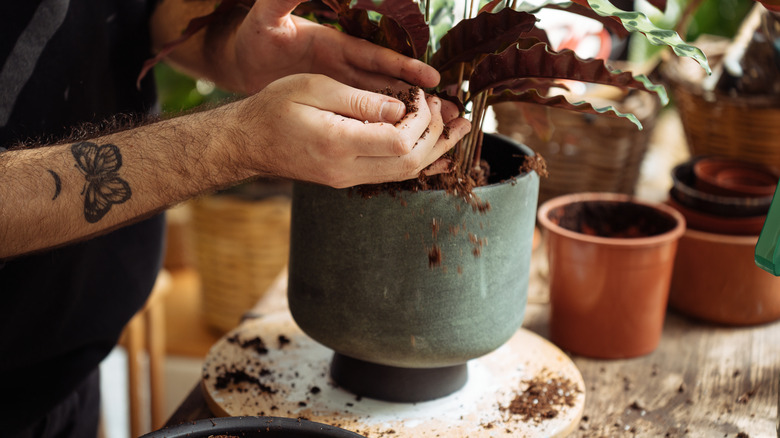Why You Should Always Sanitize Your Containers For A New Plant
It's time to transfer your thriving plant to a new container. You may have picked up a new container, perhaps even purchased soil, but have you thought about what is lurking in that container? Many people do not know they should clean a container and even sanitize to disinfect it before they transfer a plant into it. Just like drinking from a new glass you just purchased at the home improvement store, your plants are likely to grow and flourish a bit easier in a clean environment right from the start.
Even if you pull a container out of your shed, where you've had it stored for some time, it's critical to sanitize that container before using it for your plants. This is because microorganisms can live and even thrive on these surfaces, according to the University of Minnesota Extension. When you're moving a young plant or even a strong, healthy one to a new environment, you're creating a stressor. If there are germs to fight off as well, it's going to make it that much harder for the plant to do well in their new environment.
Unfortunately, there's no way to see what's present on the surface of your plant containers since most of these microbes are much too small. That's why it's always a good idea to simply assume that even a brand-new container has pathogens growing on it.
Know the risks to your plants when establishing or transferring them
Whether you are adding a new plant to your container garden or on the windowsill in your living room, it's critical to give the plant a strong, healthy start in a new environment. Providing a sterile pot for the plant to grow in creates a good starting point for the plant. This, along with a good drink of water and healthy, nutrient-rich soil, sets your plants up for success.
If you don't do this, you may notice a variety of problems develop with your plants depending on which pathogens are present. Some fungal diseases will create black spotting on the stem and leaves of plants or may cause gray mold, which looks like gray fuzz, as per "Container Gardening For Dummies." Powdery mildew, found on flowers and leaves, and damping off, which causes seedling stem rot, are all risks when the fungus is in the container. Rust is a type of fungal disease, too, which creates a brownish discoloration on the underside of leaves.
Not only is fungus a problem, but so is the presence of bacteria and viruses, which can easily lurk in your home. Bacterial diseases are numerous and can be transmitted from an insect to the container and, ultimately, to your plant, as per a University of Florida report. Without proper removal of these pathogens, the ideal climate you're creating for the plant is going to also help the bacteria, virus, or fungus grow as well.
How to sanitize your pots
It doesn't have to be a challenge to clean away any of these suspected problems. A simple way to do this is by creating a solution of equal parts warm water and white vinegar in a sink and then placing the entire container into that to soak for 10 to 15 minutes. The vinegar isn't damaging to the plant, but it will kill most types of pathogens present. It's not a good idea to use bleach for this task. While it will work to kill off bacteria, it'll also linger and potentially cause problems for the plant to grow. If you decide to use bleach, make sure it's diluted properly, with as much as nine parts of water to one part bleach) and then rinse it off before planting.
You can also use a mild detergent soap to remove dirt and debris from the surface. Warm soapy water on wood containers is the best way to get them clean. For plastic, ceramic, and harder container material, opt for vinegar. While you may use a hose to wash off stuck-on dirt and debris, do not just rely on that. After all, that doesn't sanitize them to remove pathogens. The vinegar method will do so.


